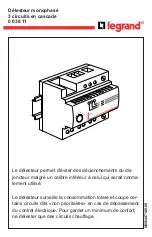
20
Checking the undervoltage stage U<
Set the switches of the SGR switchgroup as
follows before starting the test:
Switch
Position
1
1
2
1
3
0
4
0
5
1
6
0
7
0
8
0
The following relay functions are obtained:
Output relay
Function
(terminals)
A (65-66)
(Trip signal of stage U>)
B (68-69)
Trip signal of stage U<
C (80-81)
Signal on operation of
stage U<
D (77-78)
Start signal of stage U<
E (70-71-72)
Self-supervision signal
Further, switch SG1/1 is set in position 1, which
makes the relay a single phase relay.
Checking the start function
Set the test voltage at a value slightly above the
set start voltage U< of the undervoltage stage.
Close switch S1 and lower the voltage slowly
until the undervoltage stage starts and indicator
L2 is lit. Read the start voltage value from the
voltmeter.
Operate time t<
Definite time characteristic
Set the test voltage at 0.5 times the set start
voltage of the undervoltage stage. The timer is
started by switch S1, when it is closed and
stopped by contact 68-69, when output relay B
picks up.
Note!
If the test voltage setting is below 0,2 x U
n
,
switch SG1/6 must be set in position 0.
Checking the blocking function
Set switch SGB/5 of the relay module in posi-
tion 1 (ON) and switch SGR/1 in position 1.
Check the blocking function by applying a
control voltage (voltage value within the same
range as the auxiliary voltage) via switch S2 to
the control input 10-11. Set the test voltage at 2
times the set start voltage of the undervoltage
stage. Lower the voltage until the undervoltage
stage starts and indicator L2 is lit but the under-
voltage stage is not permitted to operate.
Checking the output relay of the self-supervi-
sion system (IRF)
The self-supervision system and the function of
the IRF LED and the output relay E can be
tested in the Trip test mode described in manual
"General characteristics of C type relay mo-
dules". The operation of output relay E is indi-
cated by L1.















































